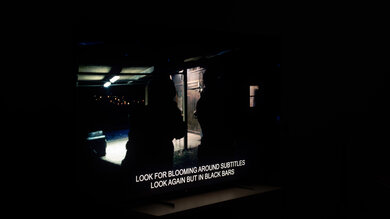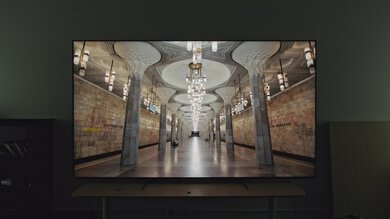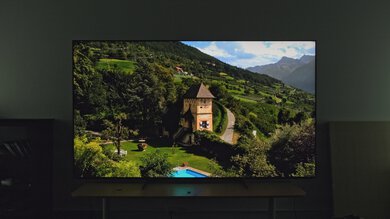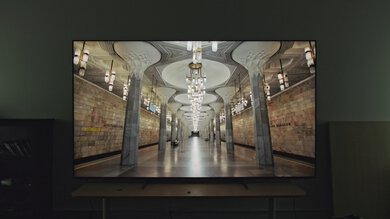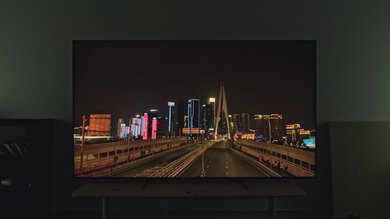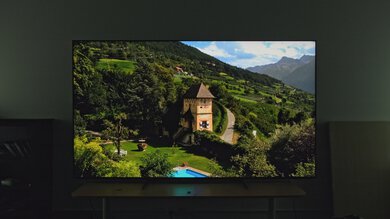The Sony X95L is Sony's flagship 4k TV in 2023. It replaces the Sony X95K from 2022 and sits above the Sony X93L in the U.S. Strangely, it's only available in an 85" size in North America, but there are 65" and 75" models in other regions. It offers impressive features, including hands-free voice control, the S-Center speaker input, and an ATSC 3.0 tuner for up to 4k broadcast support. It's powered by Sony's Cognitive Processor XR, which is designed to improve overall image processing and upscaling. It has HDMI 2.1 bandwidth and variable refresh rate (VRR) support for gamers, so you can take full advantage of the latest consoles. Like past Sony TVs, it's powered by the Google TV smart platform, which is user-friendly and has a ton of apps available to download.
Our Verdict
The Sony X95L is an amazing TV for pretty much any usage. It's bright enough to overcome tons of glare in a bright room, making it an amazing choice for watching shows or sports during the day. It also has an okay viewing angle, so it's good for a wide seating arrangement. It has impressive gaming features, including low input lag and 4k @ 120Hz support for current-gen console or PC gamers. Its Mini LED backlight delivers one of the highest contrast ratios available, making it an amazing choice for HDR content in a dark room.
-
Impressive Mini LED local dimming helps it display deep blacks.
-
Bright enough to fight glare.
-
Superb reflection handling.
-
Only available in an 85-inch size in North America.
The Sony X95L is great for watching shows in a bright room. Its high peak brightness and superb reflection handling help it overcome glare in a bright room. It also has an okay viewing angle, so you can walk around with the TV on and still enjoy a consistent image. The built-in Google TV smart interface is easy to use and has a huge selection of apps, so you can easily find your favorite shows. With the hands-free voice control feature, you don't have to worry about finding the remote.
-
No upscaling issues.
-
Bright enough to fight glare.
-
Superb reflection handling.
-
Only available in an 85-inch size in North America.
The Sony X95L is an impressive TV for watching sports. With its high peak brightness and superb reflection handling, you don't have to worry about glare in a bright room. It has an okay viewing angle, so you can comfortably sit a large group of people around the TV without fighting over the best spot. It also has a quick response time, so fast action in sports is clear and easy to make out. It has great gray uniformity, with very little dirty screen effect in the center of the screen where the action is, and it upscales lower-resolution cable sports channels well.
-
No upscaling issues.
-
Bright enough to fight glare.
-
Superb reflection handling.
-
Excellent motion handling.
-
Only available in an 85-inch size in North America.
The Sony X95L is an excellent TV for playing video games. It has incredibly low input lag, ensuring a responsive gaming experience, and it has a quick response time with very little blur behind fast-moving objects. It has a slew of extra gaming features, including VRR support, and a few PS5-specific features help optimize the picture quality for PS5 gamers. It looks great in a bright room thanks to its high peak brightness and superb reflection handling, but it's also a fantastic choice for gaming in a dark room.
-
Impressive Mini LED local dimming helps it display deep blacks.
-
Excellent motion handling.
-
HDMI 2.1 bandwidth and VRR support.
-
Low input lag for a responsive gaming and desktop experience.
-
Only available in an 85-inch size in North America.
-
Only two HDMI 2.1 ports, one of which is also the eARC port.
The Sony X95L is an excellent TV for watching movies. Its incredibly high contrast ratio delivers deep, uniform blacks in dark scenes, with almost no blooming around bright highlights. It gets incredibly bright in HDR, so specular highlights stand out well, and HDR content looks vivid and lifelike in general, thanks to its wide color gamut. It's also very good at smoothing out low-quality content, which is especially important if you're watching a lot of movies on streaming services, and it upscales DVDs well.
-
Impressive Mini LED local dimming helps it display deep blacks.
-
Removes 24p judder from all sources.
-
Displays a wide range of colors.
-
Bright specular highlights stand out incredibly well.
-
Noticeable stutter in low framerate content.
-
Only available in an 85-inch size in North America.
The Sony X95L is an amazing TV for gaming in HDR. It gets incredibly bright and combined with its incredible contrast, bright highlights in games stand out well. It delivers an incredibly smooth gaming experience thanks to its low input lag and quick response time, resulting in very little motion blur behind fast-moving objects. Finally, it supports a wide range of gaming features, including VRR and 4k @ 120Hz gaming.
-
Impressive Mini LED local dimming helps it display deep blacks.
-
Excellent motion handling.
-
HDMI 2.1 bandwidth and VRR support.
-
Low input lag for a responsive gaming and desktop experience.
-
Displays a wide range of colors.
-
Bright specular highlights stand out incredibly well.
-
Only available in an 85-inch size in North America.
-
Only two HDMI 2.1 ports, one of which is also the eARC port.
The Sony X95L is an excellent TV for use as a PC monitor. It has incredibly low input lag, resulting in a responsive desktop experience, and it has a quick response time, so there's very little motion blur behind fast-moving objects. It displays chroma 4:4:4 properly, which is essential for clear text from a PC. It has good uniformity and an okay viewing angle, but since it's only available in large sizes, it's important you sit at a comfortable viewing distance; otherwise, the sides of the screen appear non-uniform.
-
Bright enough to fight glare.
-
Superb reflection handling.
-
HDMI 2.1 bandwidth and VRR support.
-
Low input lag for a responsive gaming and desktop experience.
-
Only available in an 85-inch size in North America.
-
Only two HDMI 2.1 ports, one of which is also the eARC port.
- 8.6 Mixed Usage
- 8.3 TV Shows
- 8.4 Sports
- 8.9 Video Games
- 8.8 HDR Movies
- 8.9 HDR Gaming
- 8.7 PC Monitor
Changelog
- Updated Jun 14, 2024: Mentioned the newly-reviewed Sony BRAVIA 9 QLED in the Contrast section of this review.
- Updated May 27, 2024: We bought and tested the Sony BRAVIA 7 QLED, and added a few comparisons in the HDR Brightness, Reflections and Viewing Angle sections of the review.
- Updated Nov 08, 2023: Mentioned the newly reviewed Hisense UX in the Compared To Other TVs section of this review.
- Updated Sep 27, 2023: We rechecked the HDR Gradient performance of this TV, as it unexpectedly performs worse than other similar models, like the Sony X91J and the Sony X93L. In a side-by-side comparison with those two TVs, the difference is clear; no changes were made to this review.
- Updated Sep 14, 2023: Review published.
Check Price
Differences Between Sizes And Variants
We bought and tested the 85-inch Sony X95L, which is the only size available in North America. It's available in a 65-inch and 75-inch size in other regions, and most of these results are also valid for those sizes. The smaller sizes have lower native contrast and fewer dimming zones, so they don't look as good in a dark room. Sony doesn't provide zone counts for different sizes, so we don't know how different they are.
| Size | Model Number |
|---|---|
| 65" | XR-65X95L |
| 75" | XR-75X95L |
| 85" | XR-85X95L |
Our unit was manufactured in June 2023; you can see the label here.
Popular TVs Comparisons
The Sony X95L is the absolute best 4k LCD TV on the market in 2023, but it comes at a hefty price premium, especially as it's only available in an 85-inch size in North America. Its Mini LED panel delivers superb contrast, high peak brightness, and exceptional blooming control, and it's a well-rounded TV that performs well no matter how you plan on using it. Its closest competition is the similarly priced Hisense UX, which is also only available in an 85-inch format in North America. The Sony is a bit better overall due to its stability, color accuracy, and superb image processing, although the Hisense is brighter and more colorful.
See our recommendations for the best TVs for watching movies, the best smart TVs, and the best 80-83-85 inch TVs.
The Sony BRAVIA 9 is better than the Sony X95L. The BRAVIA 9 has a much higher contrast ratio with its better local dimming feature enabled, so blacks are deeper, and there's less blooming on it. The BRAVIA 9 is also brighter overall, so it overcomes a bit more glare in a bright room, and highlights in HDR content stand out more on it, although the X95L is no slouch in that regard. The BRAVIA 9 has better PQ EOTF tracking and better SDR pre-calibration accuracy, so it sticks closer to the content creator's intent.
The Sony X95L and the Sony BRAVIA 7 are very similar overall, but the older X95L edges out the B7 in some key ways. The X95L has Sony's 'X-Wide' viewing angle tech and a better anti-reflective coating, so it's the better choice if you have a wide seating arrangement or lots of lights/windows. The 85-inch X95L we bought and tested also has better contrast and a better local dimming feature than the 65-inch B7, but it also has more zones than the smaller sizes. It's hard to know for sure, as we haven't tested all sizes, but we expect the local dimming features of these two TVs to be similar overall when comparing two TVs of the same size.
The Sony X95L is better than the Sony X90L/X90CL. Outside of its slightly more accurate SDR and HDR image and better HDR native gradient handling, the X90L gets outpaced in every facet: the X95L is brighter with much better reflection handling, has a wider viewing angle, superior gray and black uniformity, and has the better contrast ratio. Otherwise, they have the same feature set.
The Sony X95L is better than its predecessor, the Sony X95K. The X95L features a much improved local dimming feature, resulting in deeper blacks, much better black uniformity, and less blooming around bright highlights. The X95L also has better reflection handling, but it's not a significant improvement.
The Sony X95L is slightly better than the Sony X93L/X93CL. The biggest difference between them is the number of local dimming zones. The X95L has more local dimming zones and higher contrast, resulting in a better dark-room viewing experience, with deeper blacks and better black uniformity. The X95L is also slightly brighter.
The Sony X95L and Sony A80L/A80CL OLED use different display technologies and thus excel in different contexts. The X95L is the much brighter TV of the two and looks far more vibrant in any room with lights. However, even though the X95L has fantastic contrast, the A80L has the other TV beat due to the nearly infinite contrast of its OLED panel, giving it the edge over the X95L in pitch-black rooms. The A80L also has a much wider viewing angle, giving it the edge in wide seating contexts. Regarding gaming performance, the A80L has a much faster response time than the X95L. Unfortunately, it gets much dimmer in HDR Game Mode, which is disappointing considering that it isn't the brightest TV in HDR; the X95L doesn't have that issue.
The Sony X95L is better than the Samsung QN90C. The Sony X95L has amazingly deep contrast due to its truly excellent local dimming solution, with less blooming and less noticeable lighting zone transitions than the Samsung. The Sony is also a bit brighter than the Samsung, has much better image processing, and supports DTS audio formats as well as Dolby Vision HDR. One area where the Samsung has a slight edge over the Sony is in its gaming features; the Samsung has four HDMI 2.1 ports, each capable of up to 4k @ 120Hz, while the Sony is limited to two. The Samsung also has lower input lag than the Sony, which will be noticeable for competitive gamers. Finally, the Samsung TV has native support for 1440p, while the Sony instead upscales 1440p signals to 4k, which can cause issues with some devices, like gaming consoles.
The LG C4 OLED is better than the Sony X95L, but they excel in different ways. The LG is an OLED, so it looks at its best in dark rooms due to its near-infinite contrast ratio with no blooming or lighting zone transitions. The Sony, however, is a high-end LED TV, so while it looks amazing in dark rooms, it looks far more vibrant than the OLED in bright rooms due to its superior brightness, especially in SDR and in HDR Game Mode. Still, the LG has other advantages inherent to OLED TVs: it has a much wider viewing angle, and it's amazing for gamers due to its nearly instantaneous response time, four 4k @ 144Hz HDMI 2.1 ports, and lower input lag. Ultimately, it comes down to whether you'll watch content in brighter or darker rooms.
The Sony A95L OLED is much better than the Sony X95L. The A95L delivers a much better dark room experience, with perfect inky blacks and no blooming at all around bright highlights. The A95L also has a much wider viewing angle, so if you're using it in a wide room, you can move around and still enjoy a consistent image from the sides. On the other hand, the X95L is significantly brighter, so if you only ever watch TV in a very bright room, the benefits of the A95L aren't as noticeable, so you can save some money and get the X95L instead.
The Sony X95L and the Hisense UX are two extremely high-end TVs, with the Sony being a bit better overall. The Sony is the more accurate TV of the two, not requiring to be calibrated to look its best. It also has better image processing than the Hisense, especially regarding HDR gradient handling. Finally, the Sony is more predictable, with fewer quirks than the Hisense. Still, the Hisense is significantly brighter, with better local dimming, and is the slightly more colorful TV, so it certainly pops more when both TVs are side-by-side.
The LG C3 OLED is a bit better than the Sony X95L, but they use different display technologies. While the Sony X95L has fantastic contrast, the LG C3's OLED panel gives it an even better, nearly infinite contrast for deep blacks when watched in dark rooms. However, the Sony model is a far brighter TV in HDR and SDR, so it's the better option if you prefer to watch content in brighter rooms. This is even truer in Game Mode, as the Sony doesn't lose any of its HDR brightness in that mode, while the LG is noticeably dimmer. Otherwise, the LG is the better gaming TV because it has lower input lag, a nearly instantaneous response time, and four 4k @ 120Hz HDMI 2.1 ports versus two on the Sony; just make sure to dim the lights when gaming on the LG.
The Sony X95L is better than the Samsung QN95C. Both TVs feature Mini LED local dimming, but even though the Sony TV has fewer dimming zones, Sony's algorithms are better, leading to less blooming around bright highlights in dark scenes. The Sony TV also has a wider color gamut, and Sony's image processing is superior, especially when watching low-resolution or low-quality content from streaming services or older physical media like DVDs.
The LG G3 OLED is better than the Sony X95L for most users. Although the Mini LED backlight on the Sony is getting close to OLED-level contrast, the LG still delivers a better dark-room experience, with better contrast between the deepest blacks and the brightest whites, with no blooming around bright areas. The Sony gets a lot brighter, though, so if you're not in a dark room, the benefits of the LG aren't as apparent, and the Sony is a better choice overall.
The Sony X95L and the Hisense U8K deliver similar picture quality overall, but the Sony delivers a much smoother experience, with fewer bugs or glitches and a better user experience. The Sony TV also has much better processing, so upscaled or low-quality content from streaming services looks better.
The Samsung S95C OLED and the Sony X95L are both excellent TVs that serve different purposes. The Sony can overcome more glare due to its better SDR peak brightness, so it’s the better option for a bright room on a sunny afternoon. The Samsung is a great choice for a dark room due to its better contrast with no blooming around highlights, it has a wider color gamut for more vibrant and lifelike colors, and its wider viewing angle makes it the better option for watching TV as a group. The Samsung is also better for gamers due to its faster response time and 4k @ 144Hz support.
The Sony A95K OLED is much better than the Sony X95L. The A95K delivers a much better dark room experience, with perfect inky blacks and no blooming whatsoever around bright highlights. The A95K also has a much wider viewing angle, so if you're using it in a big room, you can move around and still enjoy a consistent image from the sides. The X95L is significantly brighter, so if you only ever watch TV in a very bright room, the benefits of the A95K aren't as noticeable, so you can save some money and get the X95L instead.
Video

We buy and test dozens of TVs yearly, taking an objective, data-driven approach to deliver results you can trust. Our testing process is complex, with hundreds of individual tests that take over a week to complete. Most of our tests are done with specially designed test patterns that mimic real content, but we also use the same sources you have at home to ensure our results match the real-world experience. We use two main tools for our testing: a Colorimetry Research CR-100 colorimeter and a CR-250 spectroradiometer.
Test Results
The Sony X95L has metal feet that hold the TV very well, and there are multiple mounting positions depending on your needs. Along with the narrow position shown, the feet can be attached in a wide position (shown here) for better stability. The wide position also has a raised soundbar position (shown here) that lifts the screen so your soundbar doesn't block it.
Footprint of the 85-inch model:
- Narrow position (pictured above): 29.8" x 17.7"
- Wide Low Position: 74" x 17.7"
The height of the screen varies depending on where you mount the feet:
- Narrow position: 1.9"
- Wide low position: 1.3"
- Wide high position: 3.8"
The back of the TV is entirely plastic and made of a checkerboard pattern similar to other recent Sony TVs like the Sony X95K. There are covers that you can attach to the back to hide the inputs and for basic cable management.
The Sony X95L has excellent build quality. Although it's mostly made of plastic, the stand is made of metal and there's a metal border around the screen that feels nice. There's some flex in the back panel, but this is common and won't cause any issues. The stand also wobbles easily, especially in the narrow position, but that's not surprising for a TV this size.
The Sony X95L has exceptional contrast. The 85-inch panel's native contrast is very high despite the X-Wide Angle tech that usually reduces it. The Mini LED local dimming feature is also extremely effective at improving contrast and the dynamic range of the display, so bright highlights stand out well even very close to the deepest blacks. For even better contrast, check out the 2024 Sony BRAVIA 9 QLED.
The zone algorithms do a good job of keeping up with fast objects. Thanks to the relatively small size of each zone, there's very little flicker as bright highlights move across zones. The algorithms can't always keep up, so there's some haloing behind bright objects, and the leading edge is a bit slow to turn on.
The peak brightness in HDR is fantastic. Bright specular highlights stand out incredibly well, even if they cover most of the screen. It's a bit brighter than the lower-end Sony X93L, especially when displaying small, bright lights like the Hallway scene, and it's very similar to the newer Sony BRAVIA 7 QLED.
These measurements are after calibrating the HDR white point with the following settings:
- HDR Picture Mode: Custom
- Brightness: Max
- Contrast: 90
- Color Temperature: Expert 2
- HDR Tone Mapping: Gradation Preferred
- Peak Luminance: High
- Auto Local Dimming: High
Most scenes are slightly dimmer when you switch to the 'Game' HDR Picture Mode, but it's not a noticeable difference.
These measurements are after calibrating the HDR white point with the following settings:
- HDR Picture Mode: Game
- Brightness: Max
- Contrast: 90
- Color Temperature: Expert 2
- HDR Tone Mapping: Gradation Preferred
- Peak Luminance: High
- Auto Local Dimming: High
Like most Sony TVs, the Sony X95L has excellent PQ EOTF tracking. Most content is slightly too dark, but the difference is minor.
The peak brightness in SDR is fantastic. It's bright enough to easily overcome glare even in a room with lots of windows or bright lights. There's some variation in brightness with different scenes, but unless you're running the TV at max brightness in SDR, it's not noticeable.
These measurements are after calibration, with the following settings:
- Picture Mode: Custom
- Brightness: Max
- Contrast: 90
- Color Temperature: Expert 1
- Peak Luminance: High
- Auto Local Dimming: High
The Sony X95L has an excellent HDR color gamut, and it displays nearly the entire DCI-P3 color space used by most current HDR content. The tone mapping is excellent, but in Rec. 2020, especially pure greens and blues are a bit off.
This TV's color volume is amazing. Colors are bright and vibrant, and dark saturated colors are displayed well thanks to its extremely high contrast ratio.
With a few quick settings changes out of the box, this TV has impressive accuracy. The white balance is good, with no noticeable issues, and gamma is close to the 2.2 target. Saturated blues are a bit off, but there are no other noticeable issues with colors, although the overall color temperature is a bit warm.
The Sony X95L is easy to calibrate, and the results after calibration are fantastic. Blues are still off and are difficult to calibrate, but everything else looks great. The color temperature is very close to the target, and the white balance is nearly perfect. Very bright scenes are a bit too bright, but it's not noticeable.
You can see the full settings used for our calibration here.
The Sony X95L has an okay viewing angle. The image fades and looks a bit washed out at a moderate angle, and blues fade, giving the screen a slightly yellow tint. It's better than most VA panels, though, thanks to the inclusion of Sony's X-Wide Angle technology. The newer Sony BRAVIA 7 QLED doesn't include this feature, making it a much worse choice if you have a wide seating arrangement.
This TV has superb reflection handling. The glossy coating significantly reduces the intensity of bright lights, with minimal haloing. There's some rainbow smear, but you can always increase the screen's brightness to hide them. Unfortunately, the newer Sony BRAVIA 7 QLED has a worse anti-reflective coating, so glare is far more noticeable in a bright room.
The Sony X95L has good gradient handling in HDR. There's some noticeable banding in dark shades of green, but it's still good overall.
This TV uses a BGR subpixel layout. It doesn't affect picture quality but can cause blurry text in some applications when using it as a PC monitor. You can read more about it here.
The Sony X95L has an excellent response time, and there's very little motion blur behind fast-moving objects. There's significant overshoot when coming out of dark shades, which causes some noticeable inverse ghosting, especially in shadow details, but it's not very noticeable with most content.
There's an optional backlight strobing feature, commonly known as black frame insertion, which can be enabled to improve the appearance of motion. Unlike the Sony X93L, it can flicker at both 60 and 120Hz, so the flicker matches the refresh rate the TV is running at, eliminating most image duplication at 60Hz. The flicker timing is a bit off at 120Hz, though, resulting in noticeable image crosstalk.
Due to this TV's relatively fast response time, there's noticeable stutter in movie and TV content. It's especially noticeable in slow panning shots.
This TV removes judder automatically from 24p sources, like a Blu-ray player or an external streaming device with a 'Match Frame Rate' feature. For 60Hz sources, like a cable box, or the native apps, Motionflow has to be enabled, with both sliders at 'Min' and CineMotion set to 'High' to remove judder.
The Sony X95L supports variable refresh rate technology to reduce screen tearing. HDMI Forum VRR and G-SYNC compatibility work over the entire refresh rate range. The TV doesn't natively support 1440p, as it upscales it to 4k instead, so the VRR range is unknown.
The Sony X95L has superb low input lag in either the 'Game' or 'Graphics' Picture Mode, ensuring a smooth and responsive gaming experience. It's slightly higher than competing models like the LG G3 OLED but still low enough for casual gamers.
Most common signals are supported by this TV, up to 4k @ 120Hz with HDMI ports 3 and 4. Chroma 4:4:4 and RGB signals are displayed properly with 1080p and 4k signals, essential for clear text when using it as a PC monitor. HDMI ports 1 and 2 are limited to HDMI 2.0 bandwidth and don't support 4k @120Hz inputs.
This TV can support almost everything the PS5 has to offer. Since this TV doesn't support 1440p @ 120Hz signals, it doesn't work with that format from the PS5. As part of Sony's 'Perfect for PS5' lineup, it supports a few unique features when paired with a PS5, including Auto HDR Tone Mapping and Auto Genre Picture Mode.
HDMI ports 3 and 4 support the full 48 Gbps bandwidth of HDMI 2.1, while HDMI 1 and 2 are limited to HDMI 2.0 bandwidth. However, because HDMI 3 is also the eARC port, you lose an HDMI 2.1 slot if you connect a receiver, so you can't use HDMI 2.1 bandwidth on multiple devices simultaneously.
The Sony X95L supports eARC, allowing you to pass high-quality, uncompressed audio to a compatible receiver through an HDMI cable. It supports all major audio formats, so you don't have to worry about compatibility with external sources.
The Sony X95L's frequency response is just okay. Like most TVs, there's very little bass, but the frequency response is okay above the low-frequency extension (LFE), and dialogue is clear. It can't get very loud, though, and there's a lot of compression at max volume.
The distortion performance of this TV is mediocre. There's noticeable distortion at moderate volume levels, but it doesn't increase much at max volume, mainly since it can't get very loud.
The Sony X95L has the same Google TV smart platform as past Sony models, like its predecessor, the Sony X95K.
Unfortunately, like most TVs, there are ads throughout the interface. You can opt out of personalized ads, but this doesn't change the number of ads you'll see; they just won't be personalized to match your search and viewing history.
The Google Play Store has tons of apps available to download, and they run very smoothly. It has Google Chromecast built-in, meaning you can cast content from your phone. You can also connect a Bravia webcam for video calls.
There's a single button on the back left side to turn it on/off, change channels, adjust the volume, or switch inputs. There's also a switch to turn off the mic on the TV if you're concerned about privacy. However, these controls are set into the TV and hard to access with it wall-mounted, and the plastic covers block access to the buttons.
Comments
Sony X95L: Main Discussion
Let us know why you want us to review the product here, or encourage others to vote for this product.
Update: We uploaded the latest brightness measurements and uniformity photos for the Accelerated Longevity Test.










